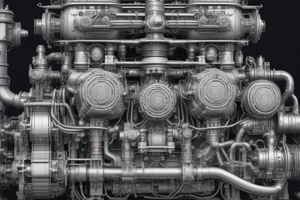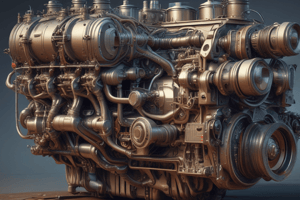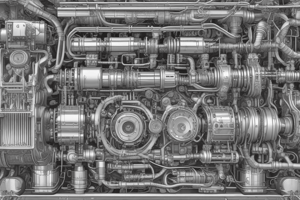Podcast
Questions and Answers
What is the purpose of supercharging an engine?
What is the purpose of supercharging an engine?
- To increase fuel consumption
- To decrease the oxygen available for combustion
- To raise the density of the air charge before it enters the cylinders (correct)
- To reduce the power output of the engine
Which term is commonly used for supercharging an engine?
Which term is commonly used for supercharging an engine?
- Forced induction (correct)
- Cycle boosting
- Natural induction
- Air aspiration
What effect does supercharging have on the mass of air inducted into the cylinder?
What effect does supercharging have on the mass of air inducted into the cylinder?
- Changes the composition
- Remains constant
- Decreases it
- Increases it (correct)
How does supercharging an engine affect the power output?
How does supercharging an engine affect the power output?
What percentage of power is consumed during the process of compressing air in supercharging?
What percentage of power is consumed during the process of compressing air in supercharging?
What aspect of an engine's performance does supercharging aim to improve?
What aspect of an engine's performance does supercharging aim to improve?
Which type of supercharger operates like a gear pump?
Which type of supercharger operates like a gear pump?
What material is commonly used to make the impellers in centrifugal type superchargers?
What material is commonly used to make the impellers in centrifugal type superchargers?
Which type of supercharger is suitable for only low speeds?
Which type of supercharger is suitable for only low speeds?
What is the main issue associated with vane type superchargers over time?
What is the main issue associated with vane type superchargers over time?
Which supercharger is driven by a gas turbine powered by engine exhaust gases?
Which supercharger is driven by a gas turbine powered by engine exhaust gases?
What additional characteristic does a turbocharger bring to the engine due to supercharging?
What additional characteristic does a turbocharger bring to the engine due to supercharging?
Why must the fuel used in a supercharged engine have better antiknock characteristics?
Why must the fuel used in a supercharged engine have better antiknock characteristics?
What drives a mechanically driven supercharger?
What drives a mechanically driven supercharger?
What effect does a turbocharger have on an engine's performance?
What effect does a turbocharger have on an engine's performance?
What characteristic makes Root's supercharger stand out in terms of maintenance?
What characteristic makes Root's supercharger stand out in terms of maintenance?
What is a limitation to supercharging as discussed in the text?
What is a limitation to supercharging as discussed in the text?
How does turbocharging work?
How does turbocharging work?
What is the purpose of valve overlap in supercharged engines?
What is the purpose of valve overlap in supercharged engines?
What can be a result of increased thermal stresses due to supercharging?
What can be a result of increased thermal stresses due to supercharging?
Which part is NOT a major component of a turbocharger?
Which part is NOT a major component of a turbocharger?
What effect does valve overlap have on supercharged engines?
What effect does valve overlap have on supercharged engines?
Why is it necessary to study factors that limit supercharging in an existing engine?
Why is it necessary to study factors that limit supercharging in an existing engine?
Which component of an engine is usually made of better materials to withstand higher temperatures?
Which component of an engine is usually made of better materials to withstand higher temperatures?
What effect does increased valve overlap have on supercharged engines?
What effect does increased valve overlap have on supercharged engines?
What phenomenon is experienced in turbocharged engines before the boost or manifold pressure increases?
What phenomenon is experienced in turbocharged engines before the boost or manifold pressure increases?
What method is used to find the friction power to estimate the performance of the engine?
What method is used to find the friction power to estimate the performance of the engine?
In the Morse test, how is each cylinder rendered inoperative in a gasoline engine?
In the Morse test, how is each cylinder rendered inoperative in a gasoline engine?
What is the main drawback of Willan's Line Method in determining friction power?
What is the main drawback of Willan's Line Method in determining friction power?
How is frictional power estimated in the Morse test?
How is frictional power estimated in the Morse test?
What does the unshaded area of the indicator diagram represent in the Morse test?
What does the unshaded area of the indicator diagram represent in the Morse test?
What is one assumption made in the Morse test?
What is one assumption made in the Morse test?
Why is it essential to take many readings at light loads in Willan's Line Method?
Why is it essential to take many readings at light loads in Willan's Line Method?
What is one limiting influence reflected near full load in Willan's Line Method?
What is one limiting influence reflected near full load in Willan's Line Method?
What does the intercept of the negative axis represent in Willan's Line Method?
What does the intercept of the negative axis represent in Willan's Line Method?
What aspect of the engine does the Morse test mainly focus on?
What aspect of the engine does the Morse test mainly focus on?
What is the main function of the waste gate in a turbocharger assembly?
What is the main function of the waste gate in a turbocharger assembly?
Which component in a computer-controlled turbocharging system controls the opening and closing of the waste gate?
Which component in a computer-controlled turbocharging system controls the opening and closing of the waste gate?
What is a significant advantage of supercharging related to power output?
What is a significant advantage of supercharging related to power output?
How do superchargers contribute to better fuel efficiency?
How do superchargers contribute to better fuel efficiency?
What kind of losses make up friction power in an engine?
What kind of losses make up friction power in an engine?
In what situation are superchargers particularly beneficial compared to naturally aspirated engines?
In what situation are superchargers particularly beneficial compared to naturally aspirated engines?
What is a key difference between superchargers and turbochargers in terms of power delivery?
What is a key difference between superchargers and turbochargers in terms of power delivery?
Which component in a turbocharging system prevents detonation in SI engines by limiting pressure?
Which component in a turbocharging system prevents detonation in SI engines by limiting pressure?
What is a significant drawback of superchargers compared to other methods of forced induction?
What is a significant drawback of superchargers compared to other methods of forced induction?
What type of valve is the waste gate in a turbocharger assembly?
What type of valve is the waste gate in a turbocharger assembly?
Study Notes
Turbocharger Assembly
- The turbocharger assembly takes time to accelerate the turbine and compressor wheel to speed up, which is why there is a delay in the delivery of boost pressure.
- The waste gate is a diaphragm-operated valve that bypasses part of the gases around the turbine wheel when manifold pressure is high.
- The waste gate is controlled by the computer, which energizes or de-energizes the solenoid to open or close the waste gate, allowing for precise control of boost pressure.
Advantages of Supercharging
- Supercharging increases power output by providing more air for combustion, resulting in improved engine performance.
- Supercharging enhances low-end torque, providing more power at lower RPMs and better acceleration.
- Superchargers perform better at high altitudes where air is less dense.
- Superchargers are more compact than turbochargers, making them easier to install in various engine configurations.
- Superchargers provide instant power delivery since they are mechanically driven.
- Superchargers can contribute to improved fuel efficiency by allowing smaller engines to produce power comparable to larger engines.
- Superchargers can reduce engine temperatures and contribute to better engine cooling.
Methods of Determination of Friction Power
- Friction power is the difference between indicated and brake power of an engine.
- Friction power is composed of pumping losses and friction losses.
- Methods to determine friction power include Willan's line method, Morse test, motoring test, and measurement of indicated and brake power.
Supercharging
- Supercharging is a method to raise the density of the air charge before it enters the cylinders, allowing for more air and fuel to be inducted.
- Supercharging does not increase fuel consumption per brake kW hour.
- A percentage of power is consumed in compressing the air, which is taken from the engine itself.
- The engine should be designed to withstand higher forces due to supercharging.
- The increased pressure and temperature may lead to detonation, so the fuel used must have better antiknock characteristics.
Types of Superchargers
- Centrifugal type supercharger: commonly used in automotive engines, driven by the engine crankshaft.
- Root's type supercharger: has two rotors of epicycloids shape, connected by gears, and operates like a gear pump.
- Vane type supercharger: has vanes mounted on a drum, which slide in or out against the force of a spring, decreasing the volume of the mixture and increasing pressure.
Comparison between Superchargers
- Centrifugal type: poor performance at low speeds, suitable for low-speed applications.
- Root's type: simple construction, low maintenance, long lifespan.
- Vane type: special problem of wear of vane tips with time.
Effects of Supercharging
- Higher power output
- Greater induction of charge mass
- Better atomization of fuel
- Better mixing of fuel and air
- Better scavenging of products
- Better torque characteristic over the whole speed range
- Quicker acceleration of vehicle
- More complete and smoother combustion
- Inferior or poor ignition quality fuel usage
- Smoother operation and reduction in diesel knock tendency
- Improved cold starting
- Reduced exhaust smoke
- Reduced specific fuel consumption in turbocharging
- Increased mechanical efficiency
- Increased thermal stresses
- Increased heat losses due to increased turbulence
- Increased gas loading
- Increased valve overlap period
Limitations to Supercharging
- Thermal load on engine parts increases
- Modifications to the engine are necessary to adopt supercharging
- Ability of the engine to withstand increased gas loading and thermal stresses
- Durability, reliability, and fuel economy are main considerations that limit the degree of supercharging
Studying That Suits You
Use AI to generate personalized quizzes and flashcards to suit your learning preferences.
Description
Learn about the importance of supercharging internal combustion engines to improve power output and meet emission legislation. Discover how small displacement engines are utilized to achieve better performance while maintaining fuel efficiency and emission control.





